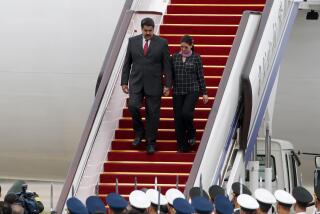Cuban Air Force Pilot Defects to U.S. : Immigration: He flies his MIG-21 jet to Florida without being detected by radar and seeks political asylum. Officials are puzzled over the incident.
- Share via
MIAMI — As the Cuban community rejoiced over the daring defection Friday of a Cuban air force pilot, U.S. officials wondered how the MIG-21 jet entered American airspace without being detected.
Capt. Enio Ravelo Rodriguez, 32, landed his Soviet-built jet at the Key West Naval Air Station early Friday afternoon after veering north while on a routine training flight. He asked for political asylum and was turned over to U.S. Immigration and Naturalization Service officials.
The jet, which was not armed with missiles, went untracked by radar on its 10-minute, 90-mile flight to the United States, according to government sources.
“We didn’t see or chase it,” said a federal official, speaking on condition that he not be named. “Neither did the Air Force.”
While Ravelo’s dash out of Cuba generated wide media attention, he is not the first Cuban military officer to fly a MIG to Florida. In March, 1991, Cuban Air Force Maj. Orestes Lorenzo was hailed as a hero here after he flew a MIG into Boca Chica Naval Air Station, near Key West.
Last December, 21 months later, Lorenzo rose to super-hero status when he returned to Cuba, this time in a borrowed Cessna 310, scooped up his waiting wife and two young children and brought them to Florida.
“This defection is confirmation of the mood of young military Cuba,” said Lorenzo in a telephone interview from North Carolina, where he now lives. “This is very encouraging. Everybody is trying to leave.”
As economic conditions on the island have grown steadily worse, Cubans have been fleeing in increasing numbers, and in a variety of ways.
On Thursday, for example, 62 Cuban rafters, in several groups, were picked up in the Florida Straits. That same day 72 Cubans who have been bouncing around the Caribbean for months in an attempt to reach the United States slipped into the Mexican Embassy in Santo Domingo, Dominican Republic, and asked for asylum.
Earlier this month several people in Oriente province risked armed Cuban guards and a minefield to enter the U.S. Navy base at Guantanamo on Cuba’s southeast coast. One of those, Omar Sanchez Vallina, 26, is in a Miami hospital, missing his left leg from the knee down after stepping on a mine.
But the perilous sea crossing remains the most popular way to travel. So far this year, 1,997 Cuban refugees, sailing in everything from inner tubes to boats carved out of Styrofoam floats, have made it across the Gulf Stream. At the present rate, the number of refugees will surpass the 1992 record total of 2,557.
“The rafters are the thermometer we use to take the temperature of Cuba,” said Carlos Solis of the Transit Home for Cuban Refugees in Key West, “and they arrive in almost anything that will float.”
“We’ve had 312 through here in August, 185 so far this month. The desperation of the people is growing and growing,” Solis said.
In another category are those Cubans who arrive in the United States through Puerto Rico, through third countries, or through the base at Guantanamo. Others arrive by planes and commercial boats that are commandeered by Cubans desperate to leave the island.
Men brandishing knives and pipes took over a Cuban ferry boat earlier this week and forced the captain and 35 passengers to head for Florida. After the boat ran out of gas, and began to leak as sharks circled, those aboard were rescued by a Panamanian freighter, according to the U.S. Coast Guard.
All were brought to Miami. Eight of those arrivals now want to return to Cuba.
Other Cubans decide to defect while on official visits outside Cuba that are approved by the Castro government. Eliseo Garcia, director of operations for Prensa Latina, Cuba’s official news service, flew into Miami from Mexico Monday and announced that he would not go back.
Many other Cubans who have fled Cuba are waiting to enter the United States. At least 108 Cuban boat people are in Nassau, the Bahamas. Eleven Cubans seeking asylum, having once made it to Mexico only to be returned to Havana, are back in Mexico and hope to travel to Miami any day now.
Researcher Anna M. Virtue contributed to this story.
More to Read
Sign up for Essential California
The most important California stories and recommendations in your inbox every morning.
You may occasionally receive promotional content from the Los Angeles Times.













